Study on Corrosion Resistance and Biological Properties of the Double Glow Plasma Nb-Zr Biological Implantation Alloying Layers
Abstract
:1. Introduction
2. Materials and Methods
2.1. Material Preparation
2.2. Characterization of Surface State of Alloying Layer
2.3. Electrochemical Corrosion Measurement
2.4. Biocompatibility Test
3. Results
3.1. Composition and Microstructure Analysis
3.2. Surface State Analysis
3.3. Corrosion Resistance
3.4. Biocompatibility Analysis
4. Discussion
5. Conclusions
- (1)
- By comparing the surface quality and corrosion performance, the optimal pressure parameter was found to be about 40 Pa. Simultaneously, we prepared a thicker Nb-Zr alloying layer, and the total thickness of it was about 15 μm, including the deposition layer and interdiffusion diffusion layer (2 μm).
- (2)
- The maximum microhardness of the Nb-Zr alloying layer was 8 GPa, which was 2.3 times that of the matrix.
- (3)
- The corrosion test shows that the alloy layer inhibited the intrusion of corrosion ions and improved the corrosion resistance.
- (4)
- The rough surface of the Nb-Zr alloying layer was more conducive to the adhesion, diffusion, and proliferation of cells, and its biological activity was higher than that of the medical 316L stainless steel.
Author Contributions
Funding
Institutional Review Board Statement
Informed Consent Statement
Data Availability Statement
Conflicts of Interest
References
- Qu, H.W.; Fu, H.Y.; Han, Z.Y.; Sun, Y. Biomaterials for bone tissue engineering scaffolds: A review. RSC Adv. 2019, 9, 26252–26262. [Google Scholar] [CrossRef] [PubMed] [Green Version]
- Li, Y.H.; Yang, C.; Zhao, H.D.; Qu, S.G.; Li, X.Q.; Li, Y.Y. New developments of Ti-based alloys for biomedical applications. Materials 2014, 7, 1709–1800. [Google Scholar] [CrossRef] [PubMed] [Green Version]
- Navarrete, R.O.; Olaya, J.J.; Ramírez, C.; Rodil, S.E. Biocompatibility of niobium coatings. Coatings 2011, 1, 72–87. [Google Scholar] [CrossRef]
- Wang, X.J.; Li, Y.C.; Lin, J.G.; Yamada, Y.; Hodgson, P.D.; Wen, C.E. In vitro bioactivity evaluation of titanium and niobium metals with different surface morphologies. Acta Biomater. 2008, 4, 1530–1535. [Google Scholar] [CrossRef]
- Yang, Y.L.; Song, Z.Q.; Xu, J. Corrosion fatigue behavior of MRI-compatible Nb-60Ta-2Zr alloy in exposure to simulated physiological solution. Int. J. Fatigue 2022, 155, 106583. [Google Scholar] [CrossRef]
- Li, B.Q.; Xie, R.Z.; Lu, X. Microstructure, mechanical property and corrosion behavior of porous Ti-Ta-Nb-Zr. Bioact. Mater. 2020, 5, 564–568. [Google Scholar] [CrossRef]
- Ji, P.F.; Li, B.; Chen, B.H.; Wang, F.; Ma, W.; Zhang, X.Y.; Ma, M.Z.; Liu, R.P. Effect of Nb addition on the stability and biological corrosion resistance of Ti-Zr alloy passivation films. Corros. Sci. 2020, 170, 108696. [Google Scholar] [CrossRef]
- Chui, P.F.; Jing, R.; Zhang, F.G.; Li, J.G.; Feng, T. Mechanical properties and corrosion behavior of β-type Ti-Zr-Nb-Mo alloys for biomedical application. J. Alloys Compd. 2020, 842, 155693. [Google Scholar] [CrossRef]
- Rubitschek, F.; Niendorf, T.; Karaman, I.; Maier, H.J. Corrosion fatigue behavior of a biocompatible ultrafine-grained niobium alloy in simulated body fluid. J. Mech. Behav. Biomed. 2012, 5, 181–192. [Google Scholar] [CrossRef]
- Wang, Y.L.; Zhang, Y.F.; Sculean, A.; Bosshardt, D.D.; Miron, R.J. Macrophage behavior and interplay with gingival fibroblasts cultured on six commercially available titanium, zirconium, and titanium-zirconium dental implants. Clin. Oral Investig. 2019, 23, 3219–3227. [Google Scholar] [CrossRef]
- Li, B.Q.; Li, C.L.; Wang, Z.X.; Lu, X. Preparation of Ti-Nb-Ta-Zr alloys for load-bearing biomedical applications. Rare Metals 2019, 38, 571–576. [Google Scholar] [CrossRef]
- Rokosz, K.; Hryniewicz, T.; Raaen, S.; Chapon, P.; Prima, F. Development of copper-enriched porous coatings on ternary Ti-Nb-Zr alloy by plasma electrolytic oxidation. Int. J. Adv. Manuf. Technol. 2017, 89, 2953–2965. [Google Scholar] [CrossRef] [Green Version]
- Kumar, A.M.; Adesina, A.Y.; Hussein, M.A.; Ramakrishna, S.; Al-Aqeeli, N.; Akhtar, S.; Saravanan, S. PEDOT/FHA nanocomposite coatings on newly developed Ti-Nb-Zr implants: Biocompatibility and surface protection against corrosion and bacterial infections. Mater. Sci. Eng. C 2019, 98, 482–495. [Google Scholar] [CrossRef] [PubMed]
- Rahman, M.; Dutta, N.K.; Choudhury, N.R. Magnesium alloys with tunable interfaces as bone implant materials. Front. Bioeng. Biotech. 2020, 8, 564. [Google Scholar] [CrossRef] [PubMed]
- Liu, W.; Liu, S.F.; Wang, L.Q. Surface modification of biomedical titanium alloy: Micromorphology, microstructure evolution and biomedical applications. Coatings 2019, 9, 249. [Google Scholar] [CrossRef] [Green Version]
- Skliarova, H.; Azzolini, O.; Johnson, R.R.; Palmieri, V. Co-sputtered amorphous Nb-Ta, Nb-Zr and Ta-Zr coatings for corrosion protection of cyclotron targets for [18F] production. J. Alloys Compd. 2015, 639, 488–495. [Google Scholar] [CrossRef] [Green Version]
- Zhou, F.Y.; Wang, B.L.; Qiu, K.J.; Lin, W.J.; Li, L.; Wang, Y.B.; Nie, F.L.; Zheng, Y.F. Microstructure, corrosion behavior and cytotoxicity of Zr-Nb alloys for biomedical application. Mater. Sci. Eng. C 2012, 32, 851–857. [Google Scholar] [CrossRef]
- Frutos, E.; Karlík, M.; Jiménez, J.A.; Langhansová, H.; Lieskovská, J.; Polcar, T. Development of new β/α″-Ti-Nb-Zr biocompatible coating with low Young’s modulus and high toughness for medical applications. Mater. Design 2018, 142, 44–55. [Google Scholar] [CrossRef] [Green Version]
- Yuan, B.; Cheng, Q.W.; Zhao, R.; Zhu, X.D.; Yang, X.; Yang, X.; Zhang, K.; Song, Y.M.; Zhang, X.D. Comparison of osteointegration property between PEKK and PEEK: Effects of surface structure and chemistry. Biomaterials 2018, 170, 116–126. [Google Scholar] [CrossRef]
- Singh, P.; Srivastava, S.; Singh, S.K. Nanosilica: Recent progress in synthesis, functionalization, biocompatibility, and biomedical applications. ACS Biomater. Sci. Eng. 2019, 5, 4882–4898. [Google Scholar] [CrossRef]
- Prosolov, K.A.; Mitrichenko, D.V.; Prosolov, A.B.; Nikolaeva, O.O.; Lastovka, V.V.; Belyavskaya, O.A.; Chebodaeva, V.A.; Glukhov, I.A.; Litvinova, L.S.; Shupletsova, V.V.; et al. Zn-doped CaP-based coatings on Ti–6Al–4V and Ti–6Al–7Nb alloys prepared by magnetron sputtering: Controllable biodegradation, bacteriostatic, and osteogenic activities. Coatings 2021, 11, 809. [Google Scholar] [CrossRef]
- Wang, Q.; Zhang, P.Z.; Wei, D.B.; Chen, X.H.; Wang, R.N.; Wang, H.Y.; Feng, K.T. Microstructure and sliding wear behavior of pure titanium surface modified by double-glow plasma surface alloying with Nb. Mater. Design 2013, 52, 265–273. [Google Scholar] [CrossRef]
- Liu, L.L.; Xu, J.; Lu, X.L.; Munroe, P.; Xie, Z.H. Electrochemical corrosion behavior of nanocrystalline β-Ta coating for biomedical applications. ACS Biomater. Sci. Eng. 2016, 2, 579–594. [Google Scholar] [CrossRef]
- Yi, J.W.; Miao, Q.; Liang, W.P.; Ding, Z.; Qi, Y.; Lin, H.; Huang, C.J.; Li, Y. A study for pre-processing of Nb diffusion in Nb-N layer by double-glow plasma alloying. J. Alloys Compd. 2020, 820, 153121. [Google Scholar] [CrossRef]
- Zareidoost, A.; Yousefpour, M. A study on the mechanical properties and corrosion behavior of the new as-cast TZNT alloys for biomedical applications. Mater. Sci. Eng. C 2020, 110, 110725. [Google Scholar] [CrossRef]
- Dong, J.J.; Fan, L.; Zhang, H.B.; Xu, L.K.; Xue, L.L. Electrochemical performance of passive film formed on Ti-Al-Nb-Zr alloy in simulated deepsea environments. Acta Metall. Sin. 2020, 33, 595–604. [Google Scholar] [CrossRef]
- Pillis, M.F.; Oliveira, M.C.L.; Antunes, R.A. Surface chemistry and the corrosion behavior of magnetron sputtered niobium oxide films in sulfuric acid solution. Appl. Surf. Sci. 2018, 462, 344–352. [Google Scholar] [CrossRef]
- Shi, K.Y.; Zhang, Y.; Zhang, J.Z.; Xie, Z.H. Electrochemical properties of niobium coating for biomedical application. Coatings 2019, 9, 546. [Google Scholar] [CrossRef] [Green Version]
- Qiao, Y.X.; Wang, X.Y.; Yang, L.L.; Wang, X.J.; Chen, J.; Wang, Z.B.; Zhou, H.L.; Zou, J.S.; Wang, F.H. Effect of aging treatment on microstructure and corrosion behavior of a Fe-18Cr-15Mn-0.66N stainless steel. J. Mater. Sci. Technol. 2022, 107, 197–206. [Google Scholar] [CrossRef]
- Han, M.K.; Kim, J.Y.; Hwang, M.J.; Song, H.J.; Park, Y.J. Effect of Nb on the microstructure, mechanical properties, corrosion behavior, and cytotoxicity of Ti-Nb alloys. Materials 2015, 8, 5986–6003. [Google Scholar] [CrossRef] [Green Version]
- Yang, J.; Wang, Z.B.; Qiao, Y.X.; Zheng, Y.G. Synergistic effects of deposits and sulfate reducing bacteria on the corrosion of carbon steel. Corros. Sci. 2022, 199, 110210. [Google Scholar] [CrossRef]
- Hussein, M.A.; Kumar, M.; Drew, R.; Al-Aqeeli, N. Electrochemical corrosion and in vitro bioactivity of nano-grained biomedical Ti-20Nb-13Zr alloy in a simulated body fluid. Materials 2018, 11, 26. [Google Scholar] [CrossRef] [PubMed] [Green Version]
- Zhang, J.; Ren, L.; Yang, K. Cytotoxicity of Ti-6Al-4V-5Cu alloy to MC3T3-E1 cells. Acta Metall. Sin. 2021, 34, 694–700. [Google Scholar] [CrossRef]
- Zhou, X.; Xu, D.K.; Geng, S.J.; Fan, Y.Q.; Liu, M.X.; Wang, Q.; Wang, F.H. Mechanical properties, corrosion behavior and cytotoxicity of Ti-6Al-4V alloy fabricated by laser metal deposition. Mater. Charact. 2021, 179, 111302. [Google Scholar] [CrossRef]
- Wu, H.Y.; Zhang, P.Z.; Wang, L.; Zhao, H.F.; Xu, Z. The role of process parameters in plasma surface chromising of Ti2AlNb-based alloys. Appl. Surf. Sci. 2009, 256, 1333–1340. [Google Scholar] [CrossRef]
- Wu, H.Y.; Zhao, X.M.; Li, J.L.; Jiang, S.; Chen, Z. Effect of processing factors on the microstructure and gradual diffusion of tungstenized layers. Appl. Surf. Sci. 2019, 477, 232–240. [Google Scholar] [CrossRef]
- Martins, D.Q.; Osório, W.R.; Souza, M.E.P.; Caram, R.; Garcia, A. Effects of Zr content on microstructure and corrosion resistance of Ti-30Nb-Zr casting alloys for biomedical applications. Electrochim. Acta 2008, 53, 2809–2817. [Google Scholar] [CrossRef]
- Wang, W.; Alfantaz, A. An electrochemical impedance spectroscopy and polarization study of the role of crystallographic orientation on electrochemical behavior of niobium. Electrochim. Acta 2014, 131, 79–88. [Google Scholar] [CrossRef]
- Kazemi, M.; Ahangarani, S.; Esmailian, M.; Shanaghi, A. Investigation on the corrosion behavior and biocompatibility of Ti-6Al-4V implant coated with HA/TiN dual layer for medical applications. Surf. Coat. Tech. 2020, 397, 126044. [Google Scholar] [CrossRef]
- Ponsonnet, L.; Reybier, K.; Jaffrezic, N.; Comte, V.; Lagneau, C.; Lissac, M.; Martelet, C. Relationship between surface properties (roughness, wettability) of titanium and titanium alloys and cell behaviour. Mater. Sci. Eng. C 2003, 23, 551–560. [Google Scholar] [CrossRef]
- Wang, X.L.; Li, B.E.; Zhou, L.X.; Ma, J.W.; Zhang, X.L.; Li, H.P.; Liang, C.Y.; Liu, S.M.; Wang, H.S. Influence of surface structures on biocompatibility of TiO2/HA coatings prepared by MAO. Materi. Chem. Phys. 2018, 215, 339–345. [Google Scholar] [CrossRef]
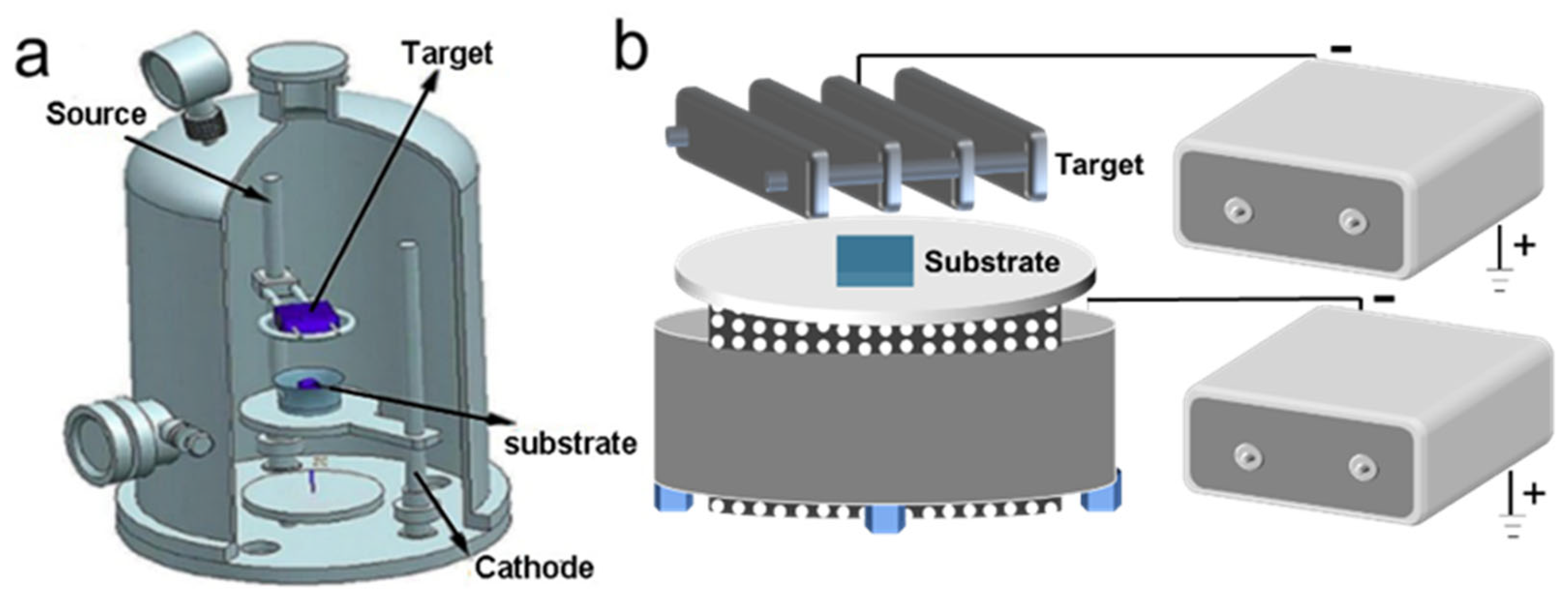
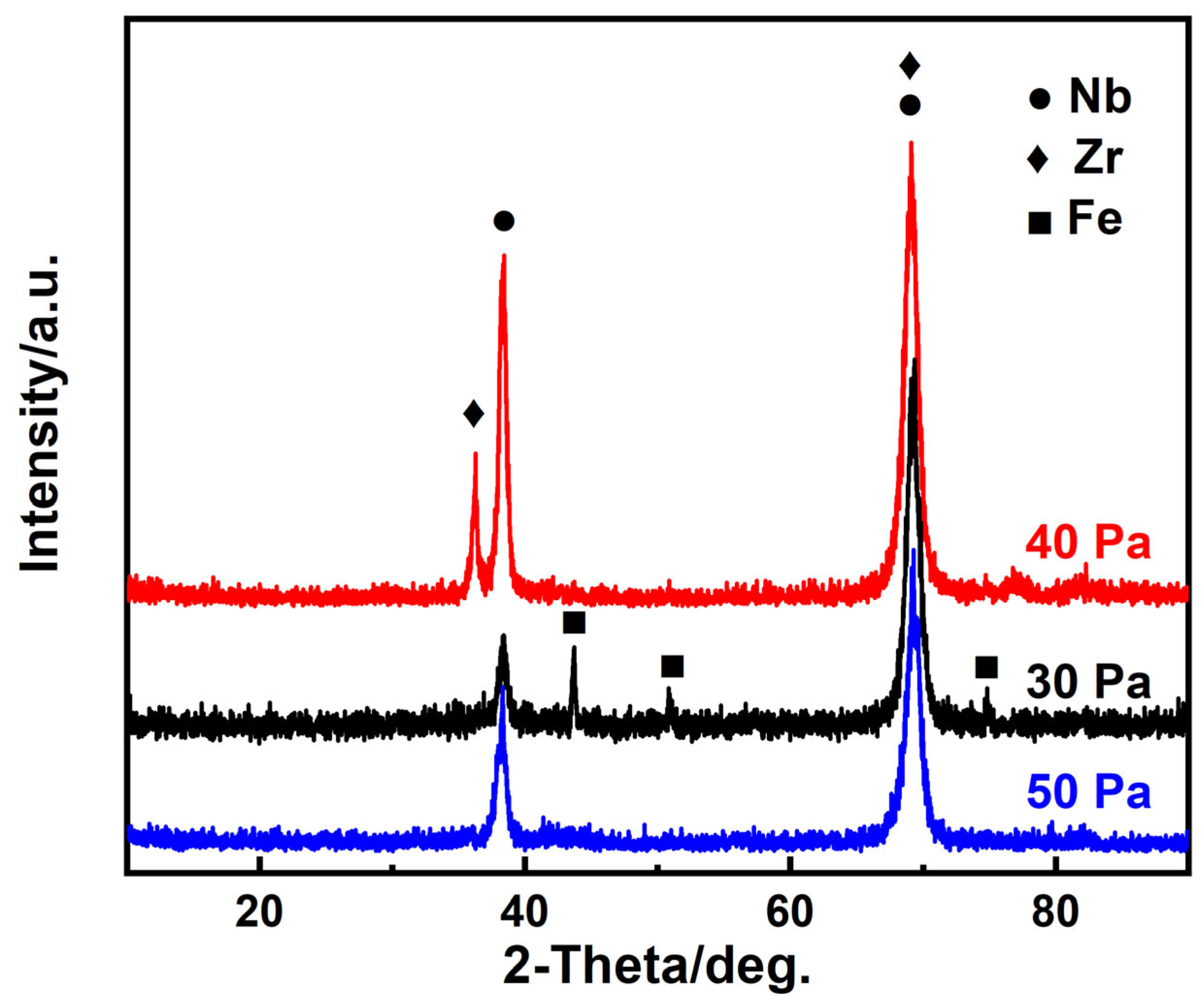

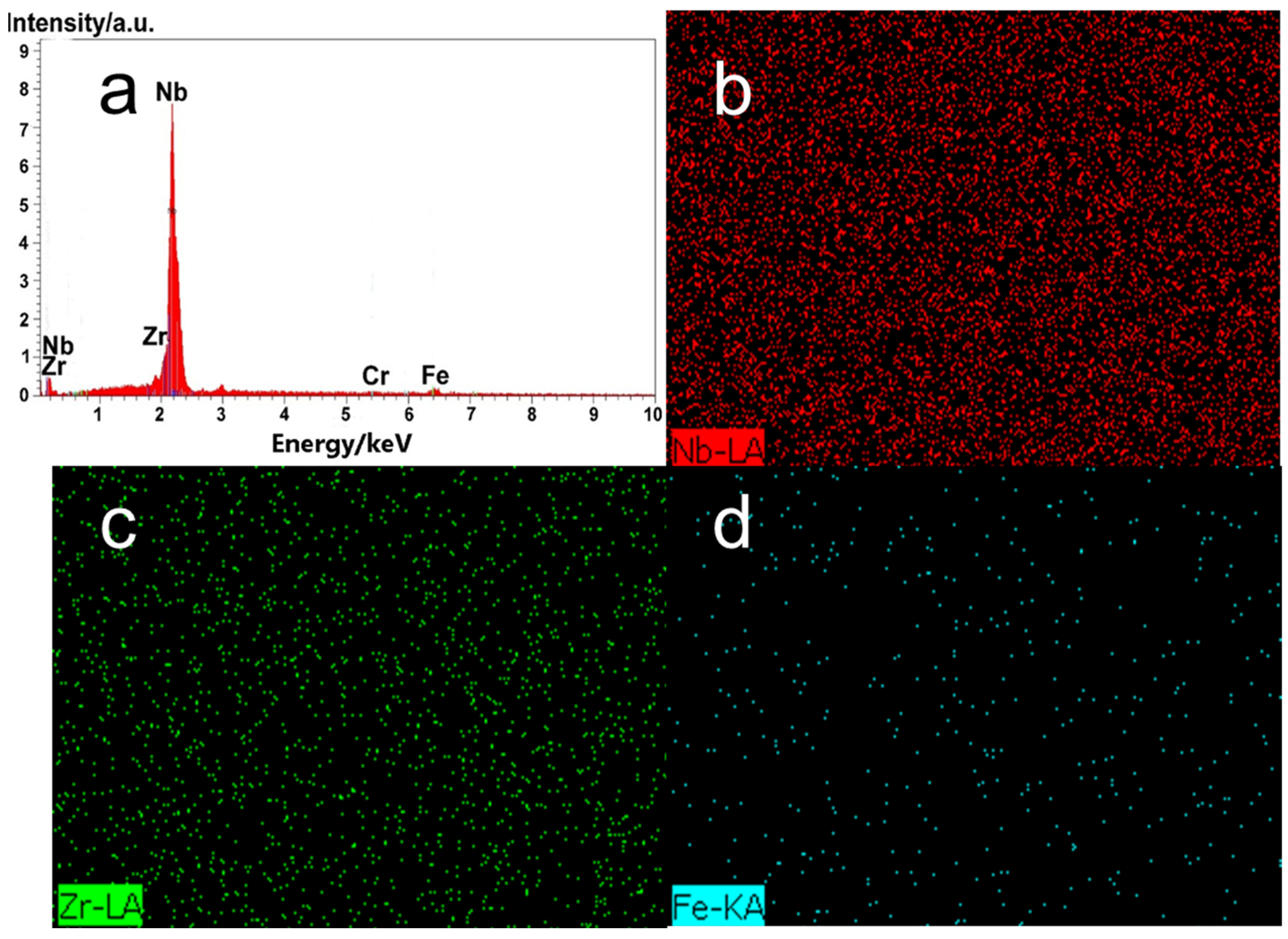
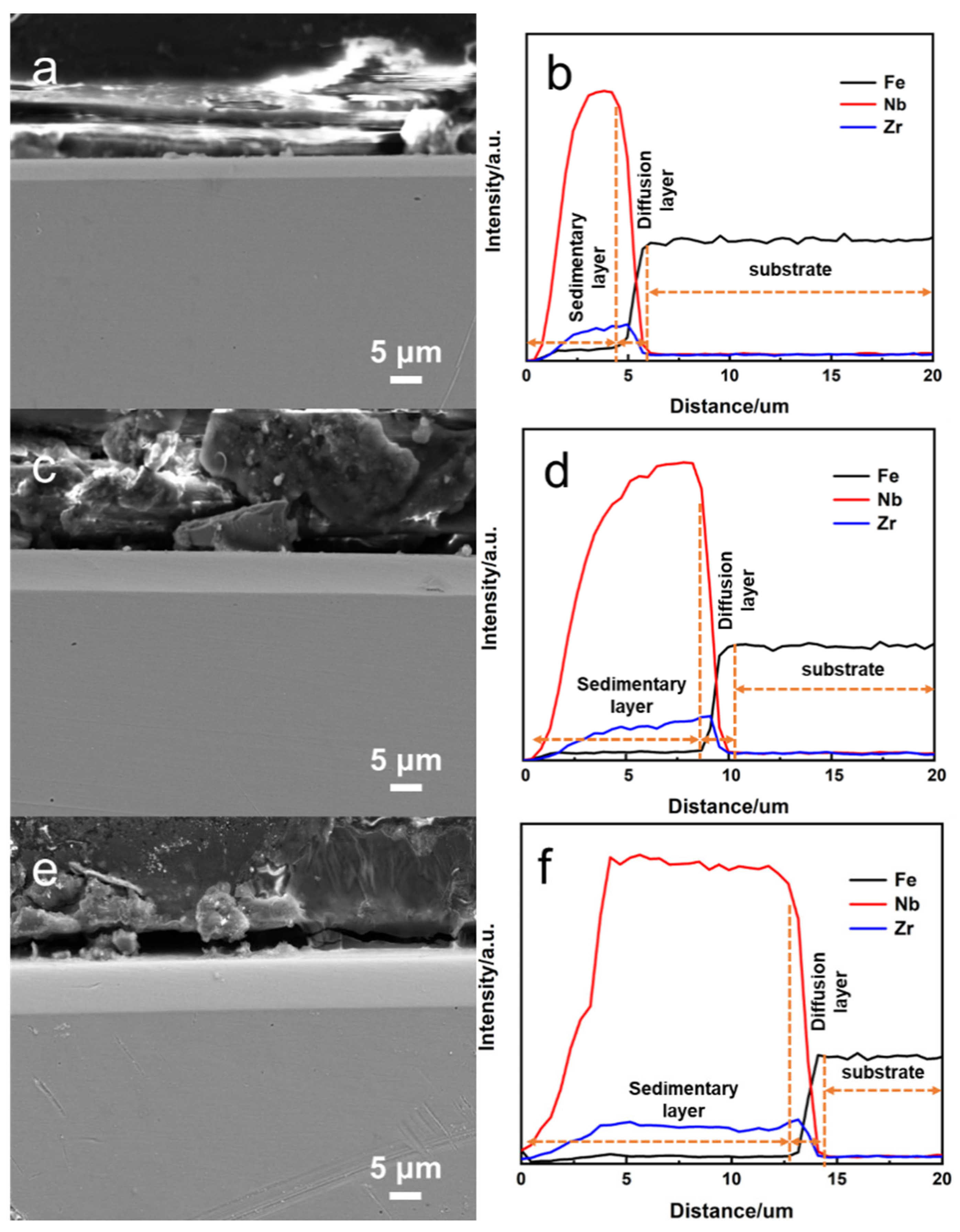
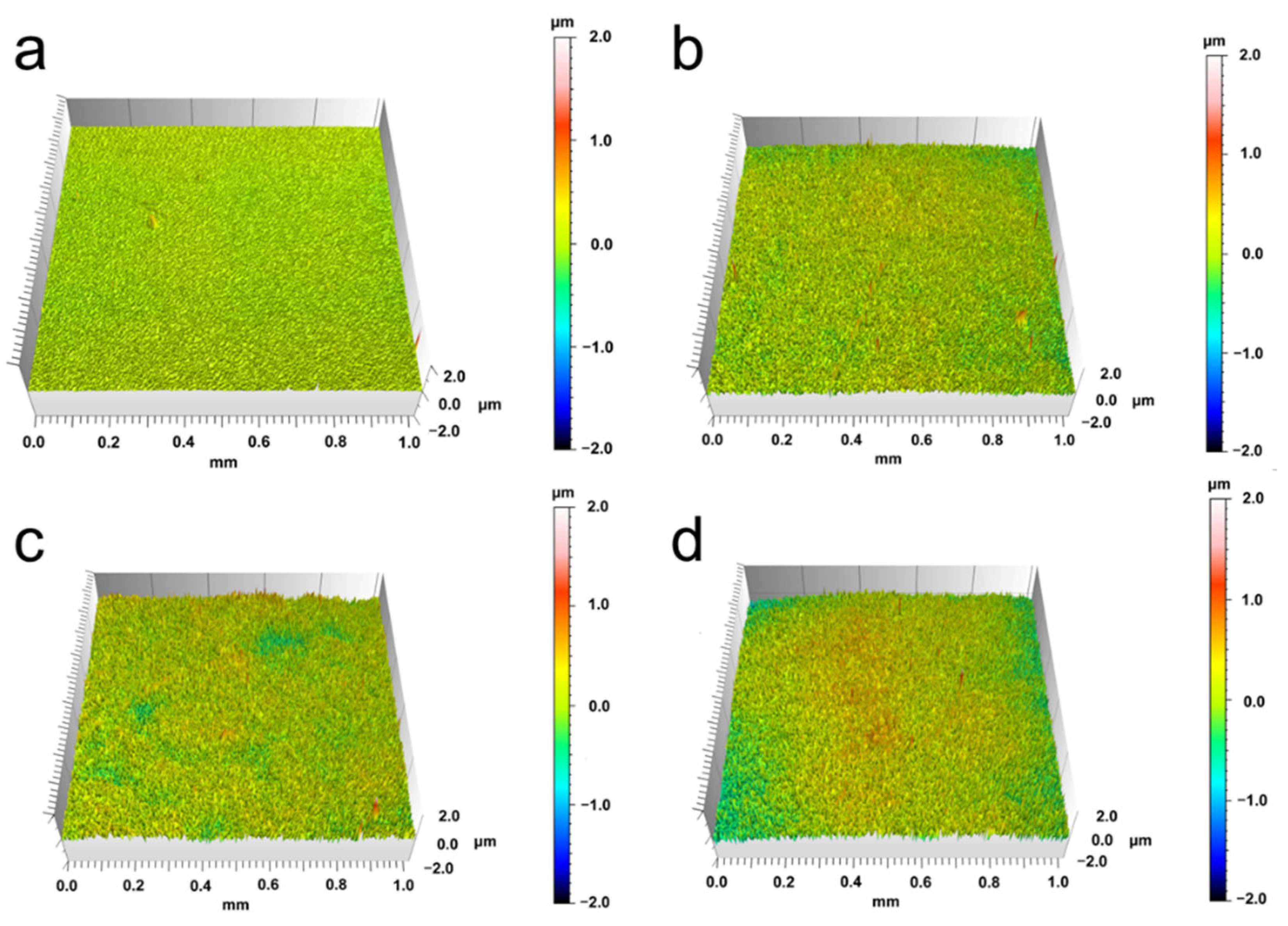
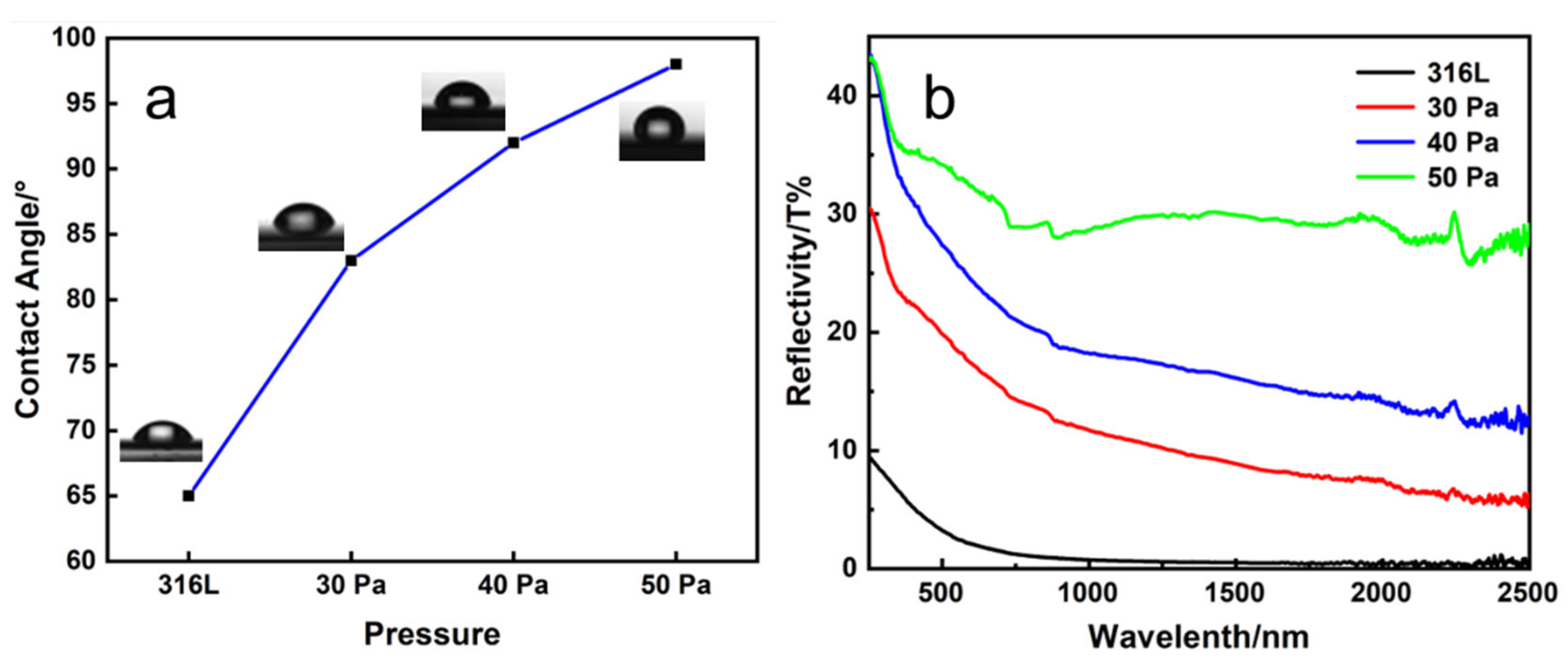
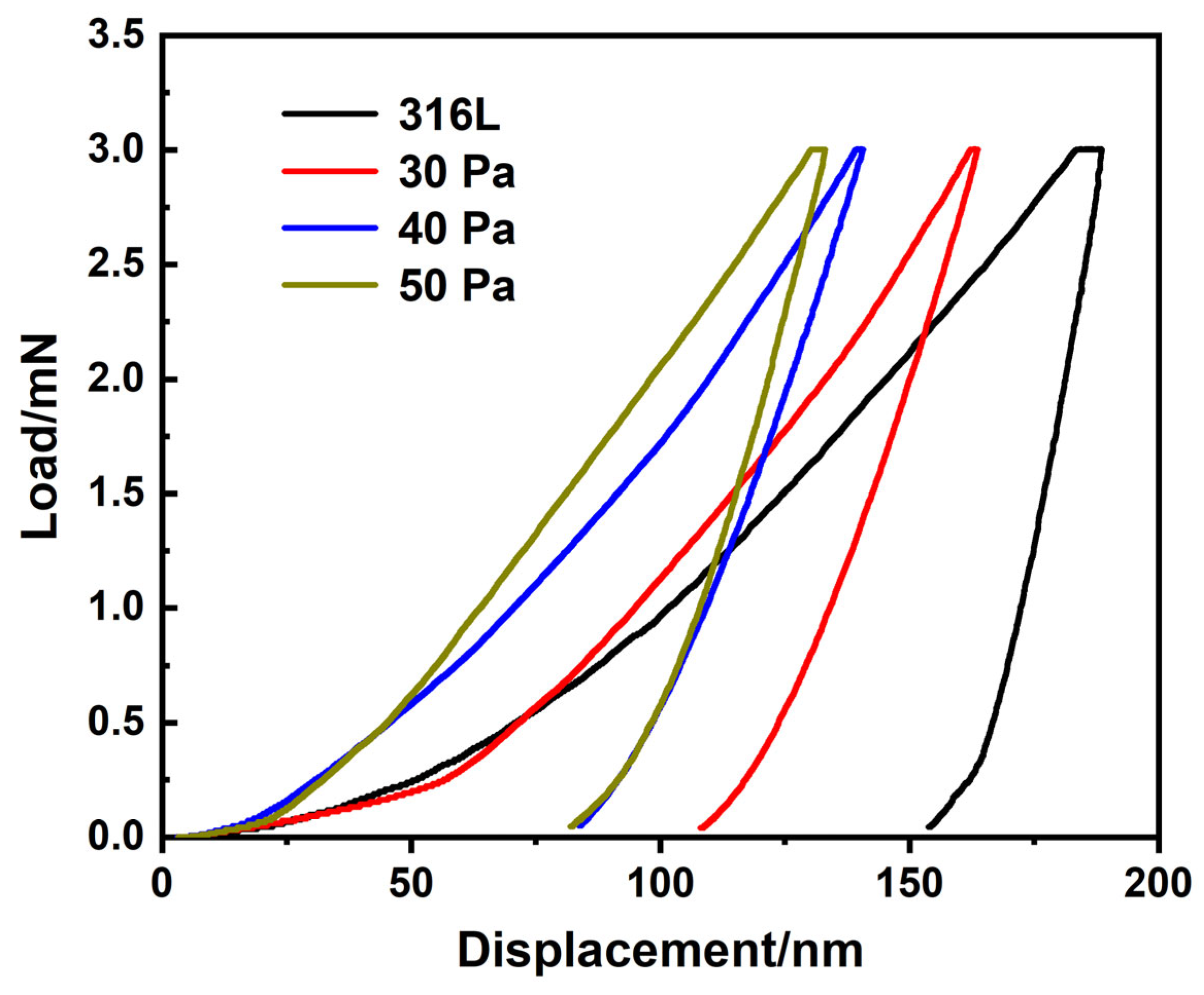
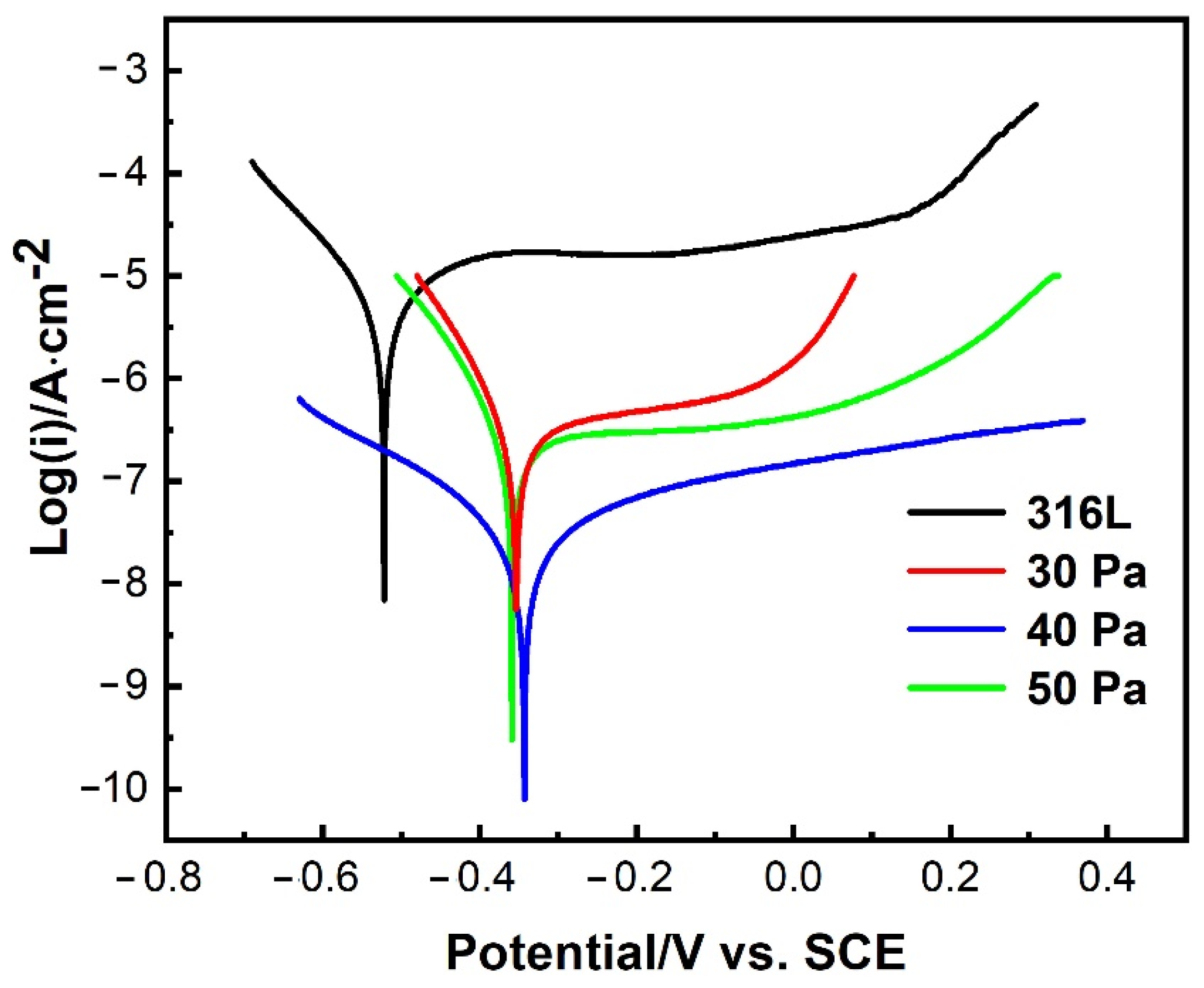
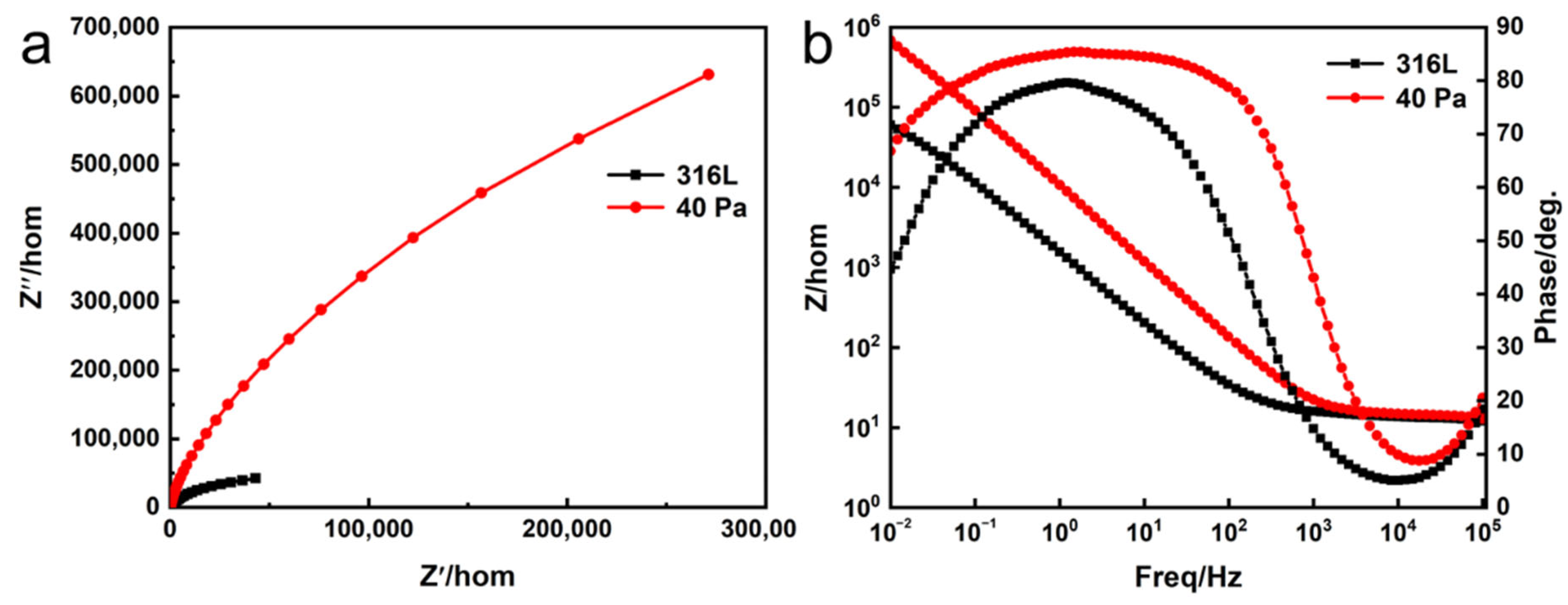
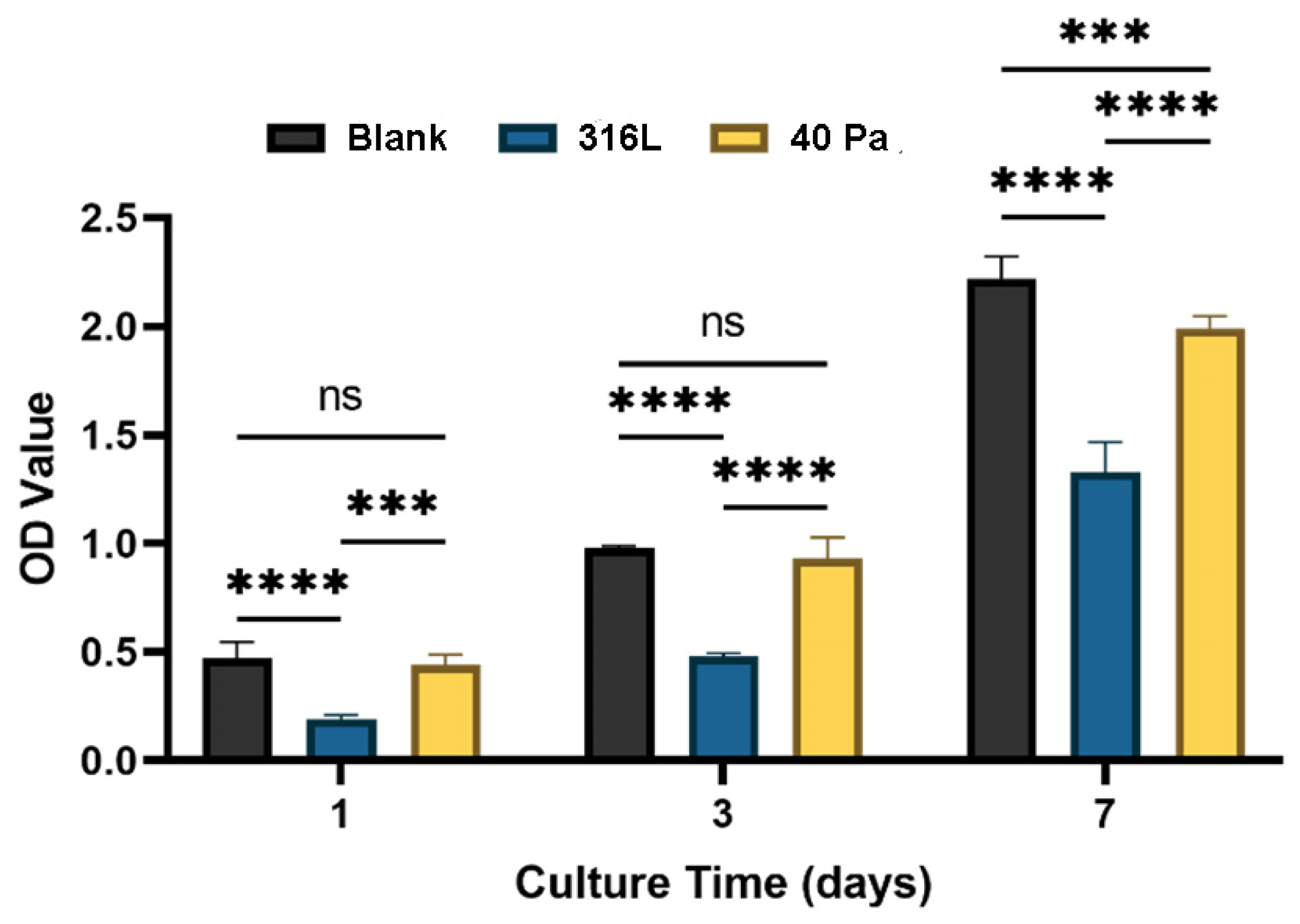

| Sample | Pressure | Source | Cathode | Time | Temperature |
|---|---|---|---|---|---|
| 1 | 30 Pa | 800–850 V | 400–500 V | 2 h | 800 °C |
| 2 | 40 Pa | ||||
| 3 | 50 Pa |
| Element | wt.% | at.% |
|---|---|---|
| Nb | 85.18 | 81.28 |
| Zr | 8.11 | 7.88 |
| Fe | 5.10 | 8.09 |
| Cr | 1.61 | 2.74 |
| Sample | Hardness/GPa |
|---|---|
| 316L | 3.52 |
| 30 Pa | 5.53 |
| 40 Pa | 8.02 |
| 50 Pa | 8.12 |
| Sample | Icorr (A·cm2) | Ecorr (V) | Corrosion Rate |
|---|---|---|---|
| Substrate | 5.05 × 10−6 | −0.52 | 0.059 |
| 30 Pa | 1.35 × 10−7 | −0.35 | 0.0016 |
| 40 Pa | 1.26 × 10−8 | −0.34 | 0.00015 |
| 50 Pa | 1.16 × 10−7 | −0.36 | 0.0014 |
Publisher’s Note: MDPI stays neutral with regard to jurisdictional claims in published maps and institutional affiliations. |
© 2022 by the authors. Licensee MDPI, Basel, Switzerland. This article is an open access article distributed under the terms and conditions of the Creative Commons Attribution (CC BY) license (https://creativecommons.org/licenses/by/4.0/).
Share and Cite
Zhao, K.; Wu, H.; Xiao, C.; Dong, J.; Ren, J.; Peng, Z. Study on Corrosion Resistance and Biological Properties of the Double Glow Plasma Nb-Zr Biological Implantation Alloying Layers. Coatings 2022, 12, 942. https://doi.org/10.3390/coatings12070942
Zhao K, Wu H, Xiao C, Dong J, Ren J, Peng Z. Study on Corrosion Resistance and Biological Properties of the Double Glow Plasma Nb-Zr Biological Implantation Alloying Layers. Coatings. 2022; 12(7):942. https://doi.org/10.3390/coatings12070942
Chicago/Turabian StyleZhao, Ke, Hongyan Wu, Changle Xiao, Jieyang Dong, Junzhao Ren, and Zhaoxiang Peng. 2022. "Study on Corrosion Resistance and Biological Properties of the Double Glow Plasma Nb-Zr Biological Implantation Alloying Layers" Coatings 12, no. 7: 942. https://doi.org/10.3390/coatings12070942
APA StyleZhao, K., Wu, H., Xiao, C., Dong, J., Ren, J., & Peng, Z. (2022). Study on Corrosion Resistance and Biological Properties of the Double Glow Plasma Nb-Zr Biological Implantation Alloying Layers. Coatings, 12(7), 942. https://doi.org/10.3390/coatings12070942






